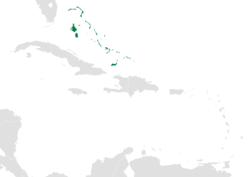The Lucayan Archipelago, also known as the Bahamian Archipelago, is an island group comprising the Commonwealth of The Bahamas and the British Overseas Territory of the Turks and Caicos Islands. The archipelago is in the western North Atlantic Ocean, north of Cuba and the other Antillean Islands, and east and south-east of Florida.
Lucayan Archipelago | |
|---|---|
 Location within the Caribbean | |
| Coordinates: 23°44′N 75°22′W / 23.74°N 75.37°W | |
| Continent | North America |
| Subregion | Caribbean |
| Countries and territories | |
| Area | |
| • Total | 14,308 km2 (5,524 sq mi) |
| Population (2016) | |
| • Total | 443,000 |
| • Density | 24.6/km2 (64/sq mi) |
| Demonym(s) | Bahamian, Turks Islander, Caicos Islander |
| Time zone | UTC−05:00 (EST) |
| • Summer (DST) | UTC−04:00 (EDT) |
William Keegan writes: "Modern political considerations aside, the islands form a single archipelago with common geological, ecological, and cultural roots."[1] Though part of the West Indies, the Lucayan Archipelago is not located on the Caribbean Sea.
Countries and territories
editThe Mouchoir Bank, the Silver Bank, and the Navidad Bank are a submerged continuation of the archipelago, to the southeast of the Turks and Caicos Islands.[2] Mouchoir Bank is disputed between the Turks and Caicos Islands and Dominican Republic; Silver Bank and Navidad Bank are part of the Dominican Republic.
Etymologies of island names
editThe Lucayan Archipelago was named for the original native Lucayan people. Julian Granberry and Gary Vescelius suggest the following Lucayan (Taíno) etymologies for various Lucayan islands.[3]
| Indigenous name | Modern name | Taíno form | Meaning |
|---|---|---|---|
| Inagua | Inagua | i+na+wa | Small Eastern Land |
| Baneque | Inagua | ba+ne+ke | Big Water Island |
| Guanahaní | Little Inagua | wa+na+ha+ni | Small Upper Waters Land |
| Utiaquia | Ragged Island | huti+ya+kaya | Western Hutia Island |
| Jume(n)to | Crooked/Jumento | ha+wo+ma+te | Upper Land of the Middle Distance |
| Curateo | Exuma | ko+ra+te+wo | Outer Far Distant Land |
| Guaratía | Exuma | wa+ra+te+ya | Far Distant Land |
| Babueca | Turks Bank | ba+we+ka | Large Northern Basin |
| Cacina | Big Sand Cay | ka+si+na | Little Northern Sand |
| Canamani | Salt Cay | ka+na+ma+ni | Small Northern Mid-Waters |
| Cacumani | Salt Cay | ka+ko+ma+ni | Mid-Waters Northern Outlier |
| Macareque | Cotton Cay | Ma+ka+ri+ke | Middle Northern Land |
| Amuana | Grand Turk | aba+wa+na | First Small Land |
| Caciba | South Caicos | ka+siba | Northern Rocky |
| Guana | East Caicos | wa+na | Small Country |
| Aniana | Middle Caicos | a+ni+ya+na | Small Far Waters |
| Caicos | North Caicos | ka+i+ko | Nearby Northern Outlier |
| Buiana | Pine Cay | bu+ya+na | Small Western Home |
| Boniana | Pine Cays | bo+ni+ya+na | Small Western Waters Home |
| Yucanacan | Providenciales | yuka+na+ka | The Peoples Small Northern [Land] |
| Ianicana | Providenciales | ya+ni+ka+na | Far Waters Smaller [Land] |
| Macubiza | West Caicos | ma+ko+bi+sa | Mid Unsettled Outlier |
| Mayaguana | Mayaguana | ma+ya+wa+na | Lesser Midwestern Land |
| Amaguayo | Plana Cays | a+ma+wa+yo | Toward the Middle Lands |
| Yabaque | Acklins Island | ya+ba+ke | Large Western Land |
| Samana | Samana | sa+ma+na | Small Middle Forest |
| Yuma | Long Island | yu+ma | Higher Middle |
| Manigua | Rum Cay | ma+ni+wa | Mid Waters Land |
| Guanahaní | San Salvador | wa+na+ha+hi | Small Upper Waters Land |
| Guateo | Little San Salvador | wa+te+yo | Toward the Distant Land |
| Guanima | Cat Island | wa+ni+ma | Middle Waters Land |
| Ayrabo | Great Guana Cay | ay+ra+bo | Far Distant Home |
| Nema | New Providence | ne+ma | Middle Waters |
| Ciguateo | Eleuthera | siba+te+wo | Distant Rocky Place |
| Lucayoneque | Great Abaco | luka+ya+ne+ke | The People's Distant Waters Land |
| Bahama | Grand Bahama | ba+ha+ma | Large Upper Middle [Land] |
| Habacoa | Andros | ha+ba+ko+wa | Large Upper Outlier Land |
| Canimisi | Williams Island | ka+ni+misi | Northern Waters Swamp |
| Bimini | Bimini | bimini | The Twins |
See also
editReferences
edit- ^ Keegan:20, 183
- ^ Carew, James; Mylroie, John (1997). Vacher, H.L.; Quinn, T. (eds.). Geology of Bahamas, in Geology and Hydrology of Carbonate Islands, Developments in Sedimentology 54. Amsterdam: Elsevier Science B.V. pp. 91-139. ISBN 9780444516442.
- ^ Granberry, Julian, & Gary Vescelius (2004). Languages of the Pre-Columbian Antilles. Tuscaloosa, AL: University of Alabama Press. ISBN 0-8173-5123-X.
{{cite book}}: CS1 maint: multiple names: authors list (link)
Citations
edit- Granberry, Julian (October 1991). "Lucayan Toponyms". Journal of the Bahamas Historical Society. 13. Retrieved 8 December 2013.
Further reading
edit- Keegan, William F. (1992) The People Who Discovered Columbus: The Prehistory of the Bahamas. University Press of Florida ISBN 0-8130-1137-X